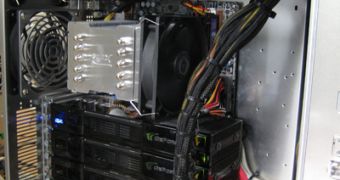Have any of you gamers out there thought that a high-performance gaming desktop system can be used for something more significant than just gaming? Well if you haven't, somebody did, namely a research group called ASTRA which is part of the Vision Lab at the University of Antwerp. The members of the group have a single professional purpose, the development of new computational methods for tomography.
And tomography is exactly what a gaming-ready high-performance desktop computer can be used for. And if you're not aware of this, tomography is a technique used in medical scanners to create 3D images of patients' internal organs. Practically, with tomography a large number of X-ray photos are put together to create a 3D model of a person's internal organs. ASTRA, the research group, is trying to develop new reconstruction techniques that can provide a better reconstruction quality as compared to classical methods.
What the group is searching for is a computing solution that can surpass their own classical methods, which, although they are very powerful, can't provide too high a speed for rendering 3D images. Just to offer you a better understanding, a normal PC can reconstruct these images in a couple of weeks. The members of the ASTRA group thought that a solution that uses a cluster of hundreds of PCs isn't the best choice, as it can be quite expensive, it requires considerably high maintenance and is not always available.
As an alternative, they developed a software application that can reconstruct 3D images with the aid of consumer 3D graphics cards, exactly like the ones you have in your own gaming system. Because every GPU on a consumer graphics card contains 128 stream processors, which work in parallel, consumer graphics cards are quite suited for tomography.
After realizing this, the research group went ahead and built a high performance desktop system, using hardware components that are commercialized for the consumer market, rather than health-related applications. With specifications, they went for some of the best high-performance hardware components they found on the market.
The case is a Lian LI PC-P80 Armorsuit, which has been chosen because it can provide eight expansion slots. The Motherboard and graphics cards have a common manufacturer, namely MSI. The K9A2 Platinum motherboard has been chosen because it can provide support for up to 4 graphics cards, on the four PCI-Express16 slots, which feature double spacing between each of them. The motherboard also provides support for AMD processors, although initially the group wanted to go for an Intel processor. They gave up that idea, because they couldn't find any Intel-based mobo that can provide four graphics lanes and because the processor doesn't play such a significant part in what they were planning to build.
The graphics cards are based on NVIDIA's current flagship, namely the GeForce 9800GX2, which provided the system with 8 GPUs and a total of 1024 stream processors. The other components included a Phenom 9850 CPU cooled down by a Scythe Infinity cooler, 8 GB of Corsair's TWINX DDR2 memory and a Samsung Spinpoint F1 750GB. All of these components were powered by a Thermaltake Toughpower Modular PSU, which provided no less than 1500W.
With an overall cost of 4000 Euros, this system provided the researchers with an alternative solution for reconstructing 3D images. The system was dubbed FASTRA and you can find out more about it by checking their presentation video, from YouTube:

 14 DAY TRIAL //
14 DAY TRIAL //